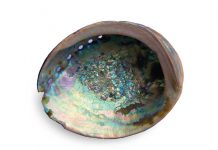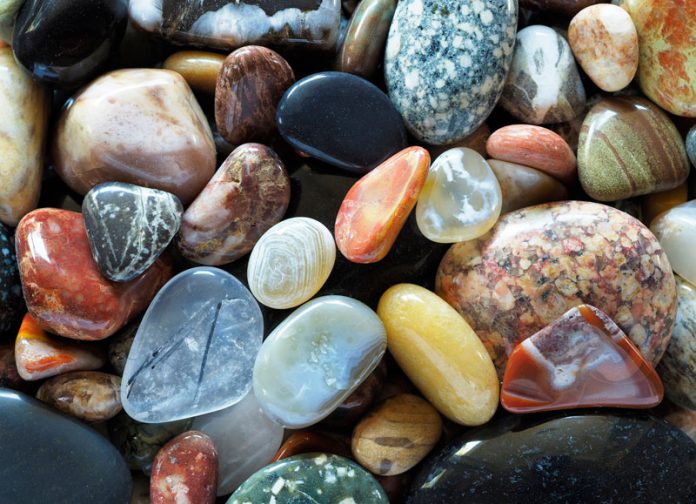
Rock tumbling is a fun and rewarding hobby that transforms rough stones into beautifully polished gems. But not all rocks are ideal for this process. If you’re new to rock tumbling or want better results, choosing the right types of rocks is key. Here’s a guide to the best rocks for tumbling and how to get the most out of your tumbler.
Polished Rocks Through History
Rock tumbling has been happening for millions of years. But when did our romance with tumbling rocks begin? How did that first shiny cache of glistening stones inspire our predecessors to seek out replicating such natural earthly treasures?
“Under the rocks and stones, there is water underground.” ~ Talking Heads
The answer lies in (among other places) the lyrics of the 1970s art rock band, Talking Heads: Water.
Rock tumbling began millions of years ago, as waves and streams tumbled Earth’s first sediments. Over time, the more ingenious of our ancestors discerned how such natural processes shaped and smoothed some rocks more than others. Moving water became the first “rock tumbler.”
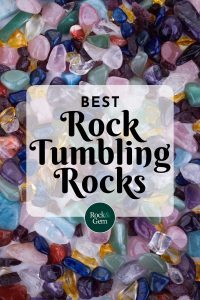
For thousands of years, we have respected the power of water, but only recently has science explained how something so benign and malleable can wear away stone.
In April 2022, a first-of-its-kind study, led by University of Minnesota-Twin Cities researchers, announced it had taken a closer look at how water erodes hard surfaces and concluded that tiny droplets behave like miniature bombs.
“There are similar sayings in Eastern and Western cultures that ‘dripping water hollows out stone,’” said Xiang Cheng, senior author of the research paper and associate professor at the University of Minnesota Department of Chemical Engineering and Materials Science.
“Such sayings intend to teach a moral lesson: ‘Even if you are weak, if you do something continuously, you will make an impact.’ But when you have something so soft as droplets hitting something so hard as rocks, you cannot help wondering, ‘Why does the drop impact cause damage?’ That question motivated our research.”
Their discovery, published in Nature Communications, outlined how a new technique called high-speed stress microscopy measured the force, stress, and pressure underneath liquid drops as they hit a surface. They found that the force exerted by a droplet spreads out with the impacting drop instead of concentrating in the center of the droplet, briefly exceeding the speed of sound as it spreads and creating a miniature “shock wave” across an impacted surface.
“Each droplet,” the team noted, “behaves like a small bomb, releasing its impact energy explosively and giving it the force necessary to erode surfaces over time.”
And to think, all those micro-bombs were organically exploding as Egyptian slaves slushed rough-hewn rocks, for months at a time, in troughs filled with sand and water. Or, as Indian lapidaries rolled goat skin polishing bags filled with water and grit along the ground, or shook jars of water, abrasives, and pre-cut beads up and down on pre-tumbler “teeter-totter” boards.
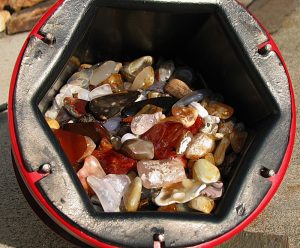
What Makes a Great Rock for Tumbling – Mohs Hardness Explained
That said, not every type of stone is up to the task of enduring microscopic bombings in pursuit of that perfect shine.
“We were the first in the area to carry raw stones because it was growing more popular. People want to tumble their stones,” says Christine Seebold, evidential medium and owner of the Mind Body Spirit Center, with locations in Albany, Clifton Park, and Saratoga Springs, New York.
“We try to give everyone a variety of stones to try, plus we do a rock tumbling kit for kids, which includes two dozen of the best basic choices.”
What makes the best basic choice? A great place to start is at that tried and true standard established in 1812 by German mineralogist, Friedrich Mohs. He chose 10 different minerals of varying degrees of hardness and assigned them a score of one (softest) to 10 (hardest).
The ideal Mohs scale of hardness for rock tumbling success is between five to seven. One of the tumbling’s easiest tips to remember is ‘seven days for a hardness of seven,’ and standard rock tumbling instructions are generally based on material with a Mohs hardness of about seven including agate, chalcedony, jasper, quartz, and petrified wood.
In Why Mohs Hardness Is Important, Hobart M. King of Rocktumbler.com wrote that if you are tumbling a rough with a hardness of six, it will not take as long to shape and smooth as a rough with a hardness of seven. “Our opinion is that you can reduce the number of tumbling days by about one-and-a-half days for every degree of hardness under seven.”
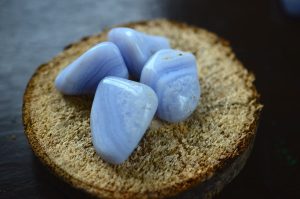
Adobe Stock / Holly
Quartz: Classic Mohs 7 Rock for Brilliant Tumbling Shine
Quartz is the benchmark mineral for a seven on the Mohs Hardness Scale and standing toe to toe with it is another top choice for tumbling, chalcedony.
Don’t let its occasional delicate transparency and a wide variety of hues (thanks to impurities in an otherwise colorless state) fool you. Chalcedony can roll with the best of them and is the generic name for any kind of microcrystalline quartz, although its white and blue forms are most often referred to as chalcedony. (Fun fact: it’s also the flint used in ancient tools and weaponry.)
Agate & Jasper: 5–7 Mohs Favorites for Rock Tumbling
Agate and jasper are varieties of chalcedony. All are colorful, durable, inexpensive, and deliver a satisfying luster after tumbling. An easy way to remember one from the other is that agate is any type of chalcedony that is translucent; jasper is chalcedony that is opaque, thanks to a greater degree of impurities mixed with its silica/quartz. Agate and jasper can form in the same volcanic environment, so it’s not uncommon for a single rock to contain both translucent (agate) and opaque (jasper) portions.
Polished agate as ornamentation dates back to the Bronze Age (3300 B.C. – 1300 B.C.) in Asia, and the third century B.C. Greece. It derived its name from the naturalist Theophrastus, who named agate after the Sicilian shoreline of the Achates River where he found the stones. Popular agates include descriptive lace and moss agates, turritella (including petrified wood), and iridescent fire agate.
Varieties of jasper include imperial (green), the rarest — according to writer and rock seeker Jeremy Hall — so be sure of what you’re buying; brecciated (colorful red and yellow nodules); the dreamlike landscape; poppy, named for its distinctive tiny “blooms,” and ocean, found only at low tide in Madagascar.
Chalcedony: Common and Colorful Rock Tumbling Material
Other types of chalcedony to consider for tumbling are aventurine, whose tiny inclusions look like shimmering flakes; carnelian and heliotrope (aka “bloodstone”); blue (Mt. Airy Blues or Mohave) or slightly lavender chalcedony, known as holly blue and found only in Oregon; and since the organic matter in petrified wood is often replaced by (opaque) chalcedony, it can technically be classified as jasper (and tumbles at roughly the same rate, four to five weeks, as agate or jasper).
Christine says other rocks her collectors love to tumble are quartz and tiger’s eye. Tiger’s eye, a crystalline type of quartz, can be polished to a high luster, but experienced tumblers warn that tumbling pieces larger than an inch in size can result in “bruising” along the edges of the rocks, caused by quartz-on-quartz impacts inside a tumbling barrel.
Your best prospects are hard, dense, and smooth rocks like those mentioned above; avoid tumbling rocks with a gritty texture or that prove too soft after a “scratch test” (where a mineral, after being scratched by another mineral, will fall on the Mohs Hardness Scale).
❓Rock Tumbling FAQQ: What is the best rock for rock tumbling?A: Agate is often considered one of the best rocks for rock tumbling due to its hardness and variety of colors. Q: Can you tumble any kind of rock?A: Not all rocks are suitable. Soft or porous stones may not polish well or can break down in the tumbler. Q: How long does rock tumbling take?A: Depending on the material and number of tumbling stages, the process can take from a few days to several weeks. Q: What tools do I need for rock tumbling?A: You’ll need a rock tumbler, grit in multiple stages, water, and suitable rocks. |

Rockin’ TikTok
What’s hot in rocks is also being determined by younger, more social voices.
“We have kids come into the store educating their parents,” says Christine. “TikTok videos are teaching a lot of kids about stones and crystals. By the time they come into the store, they already know what they’re looking at and what they want. They say, ‘This way, Mom.’ They already know the stones they want.”
Driving popularity can also drive demand for certain rocks.
“Muldovite,” sighs Christine, citing a recent example of a rock so popular (thanks to TikTok) that it was hard to keep in stock or, from a metaphysical standpoint, align with the right energies.
“This is a really intense stone of transformation and spiritual awakening,” she says of the rare green tektite from the Czech Republic. “I had three people in one week come into my shop asking for it, and when I asked, ‘Are you sure? That’s a strong stone,’ they said, ‘Yes. We saw it on TikTok.’”
She’s not exaggerating. An April 30, 2021, article in Cosmopolitan by Rebekah Harding cited how muldovite, during the pandemic, racked up more than 280 million views on TikTok and its digital spiritual cousin, WitchTok.
“There’s a neat reason this tektite became one of WitchTok’s biggest and most long-lived trends,” Harding wrote. “Moldavite removes blockages and obstacles on your path toward becoming your highest self. Often in the most chaotic way possible.”
So, muses Christine, “If you can’t find a certain stone, it might be because it is selling out on TikTok as ‘Stone of the Week!’”
TikTok trends are a long way from the days of goatskin bags and sand-filled troughs, and yet the attraction we feel for a pretty, shiny stone endures.
Rock Tumbling: Conclusion
Rock tumbling ultimately transforms rough stones into polished gems, but the process starts with choosing the right rocks. Stones like agate, jasper, quartz, and petrified wood all fall within the ideal Mohs hardness range, offering both durability and shine. Whether you’re just getting started or refining your technique, selecting rocks that tumble well will make all the difference in your final results. With a little patience, the right materials, and a reliable tumbler, your rock tumbling journey can yield stunning stones worth collecting, gifting, or displaying.
This story about rock tumbling previously appeared in Rock & Gem magazine. Click here to subscribe. Story by L. A. Sokolowski.


